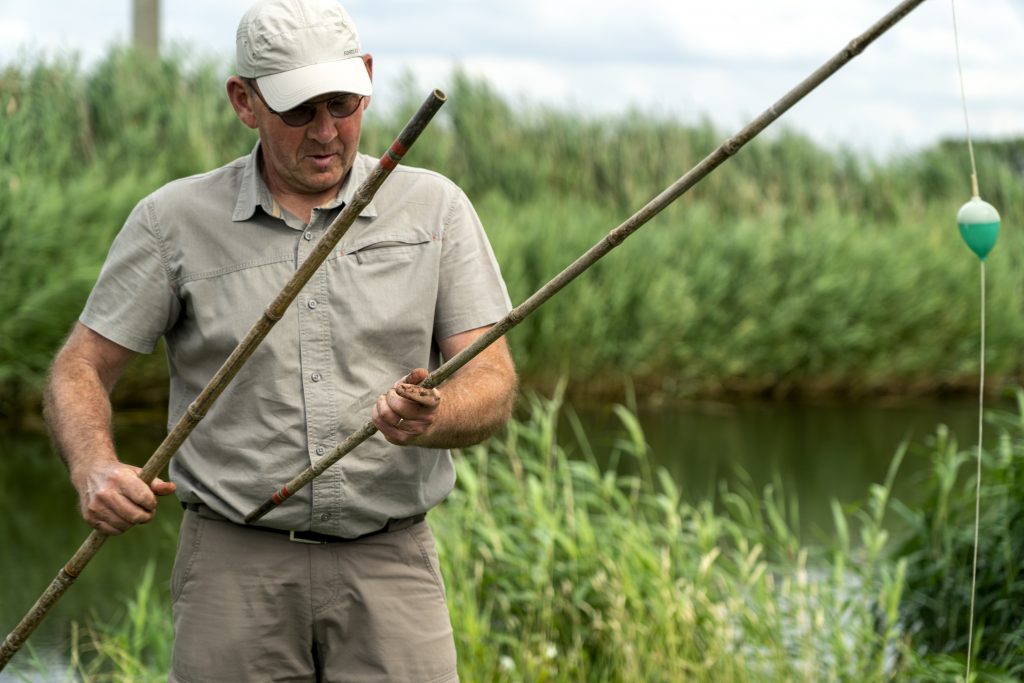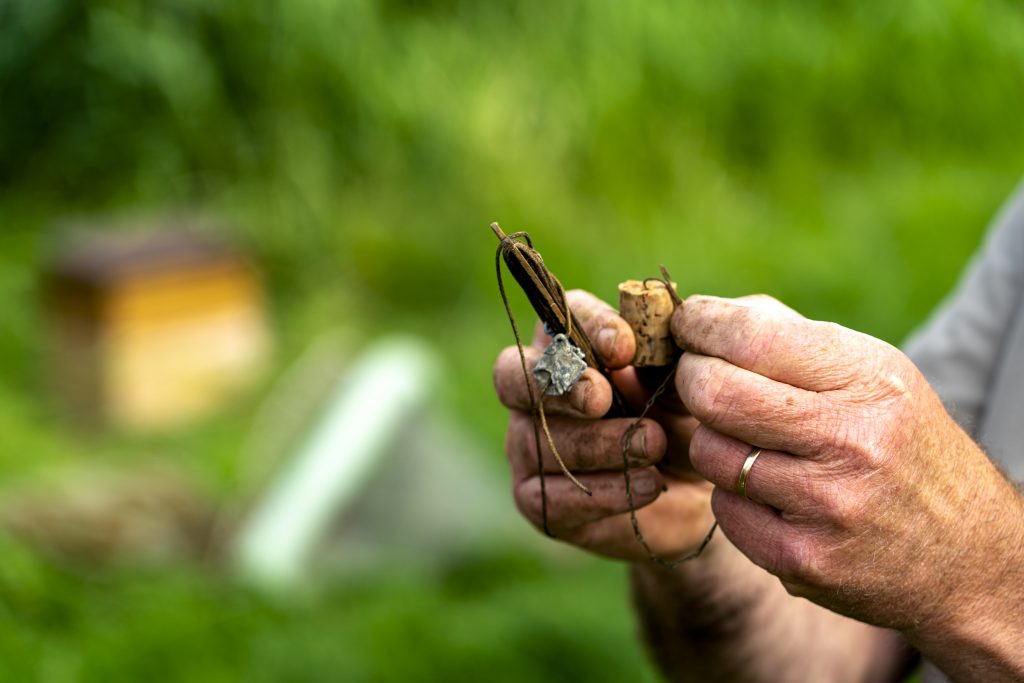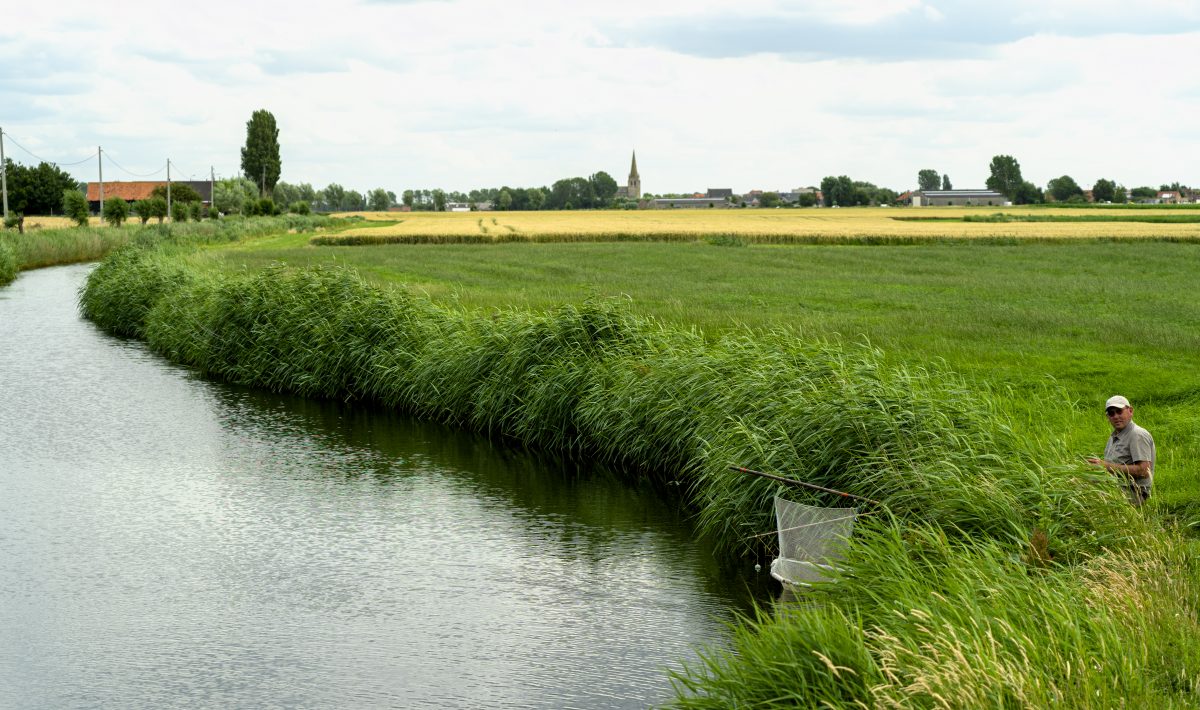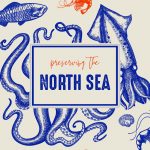Eels in the Mud
Last week Jennifer and I visited the farmlands surrounding Veurne, Belgium. It seemed to me an odd place to meet a fisherman. I thought this was going to be about traditional fishing in the North Sea, not Flemish wheat fields. As we approached, a burly looking guy was taking nets from the back of his van and tossing them in the grass. It was an odd contrast to see fishing tackle among wheat and alfalfa. The grass leaves stretching on behind him. Far beyond, I caught sight of a silhouetted church tower on the horizon. A horse barn was out there too. As we descended a dirt path, I took note of the stone bridge spanning the narrow canal below. I wondered if it, like many of the nearby structures, dated as far back as the 17th century.
His name was Kurt. He’d lived his entire life in that small village situated in a dense network of canals not far from the sea. At the age of five he received his first net. From then on, it and the eels it carried became his constant companions. He said he grew up fishing out of the canals, or ‘grachts’ in his local dialect. Almost 50 years had passed since then. That was a time when European eels churned the waters of Flanders fields.
In his recollections, Kurt painted a picture as vivid as any of the famous Flemish painters of the past. After dinner, he would slip out of the house to run along the canals. Evening time was eeling time. In one hand he held up his petroleum-fueled lamp as a guide. He was searching for a space between the men working the water. In the other hand he carried his long wooden rod. His square green net for capturing the slippery animals hung on his back, inside he stowed his coffee can which contained the secrets of a traditional eel fisherman.
Once he found a space to set up his gear, he look across the reflection on the surface of the canal. He learned quickly to read the ripples of the water. The eels could be seen moving through the locked up water. They could be caught on a line or in a dip net. In the spring their dark brown scales even kept them hidden in the muddy banks where they would hunt for food.
One can never know where the eel lays, as the saying goes.
—Kurt Lermytte, traditional eel fisherman
But that didn’t stop the him or the others out there every evening from finding them. Eel was a regular, even common, ingredient in the kitchen. Within Kurt’s lifetime, villagers could, if they chose, make a regular living selling what they caught. Kurt described one man who was so productive he pimped his bicycle to transport eels directly from the canal to the train station. From there the Veurne eel were delivered to surrounding towns and, when supplies were good enough, onto the fresh markets in Brussels. At the time, over 40 years ago, eel sold for 10 Euros per pound. A tidy sum for those days, and more than enough to earn the man a legacy that locals still recall today.
An amateur in the truest sense, Kurt was always only doing it for the pleasure of traditional fishing. And like anyone who’s ever landed a catch, he had some great stories to tell. One evening as a young man, he caught an eel that was over a meter long and over 10 kilos. I imaged the power it must have taken to haul that massive eel onto shore, skin it alive and get in a box to take home. I also imagined the number of mouths his mother would have fed with it. And the rich ‘paling in ‘t groen’–eel in the green–she would have made: a creamy, krypton sauce as thick with lightly steamed eel as the canal itself.

A Life History
Besides Jen and I, there were 8 other participants gathered in the shadow of the stone bridge to see Kurt’s demonstration. Once he had fastidiously arranged all of his gear on the ground, he left it and turned to us. Without being asked, the group immediately quieted down, ready to listen to what he was ready to tell us. Instead of talking about the materials he had gathered, he began with a polished depiction of the European Eel’s life cycle. Ah, I thought, he’s a real storyteller; he’s laid out his props to grab our attention, but he’s keeping their secrets and keeping us guessing. Needless to say, Kurt already had me hooked.
It turns out that eels have quite an adventurous life. They spawn in the crystal blue waters of the Saragosa Sea. And so they begin their lives way out in the heart of the Atlantic Ocean, nearer to the eastern seaboard of the United States than the Canary Islands of western Europe. The young eels, at first shaped like thin blades of grass, begin a great migration. Some will follow the currents only so far as North America, but others will have an Odyssean journey ahead of them.
After a trans-oceanic crossing, they will follow the western coast of the European continent. Some of these world famous ‘glass eels,’ as they’ve come to be known, will be illegally poached and served in Spanish and Moroccan kitchens. The remainders will will just keep swimming. Soon they’ll make their way across the English channel. And finally, they will turn follow the great Gulf Stream conveyor belt to where it begins to peter out: the gap between the Shetland Islands and Orkney. The North Sea may be the last leg of their marine transit, but the sea itself is not their destination.
As they enter the brackish waters on the coast of the low countries, the eels will metamorphose into the lesser known yellow eel. After thousands of kilometers riding the river-like tides of the ocean current, the face a final, strenuous push into the fresh water farther inland. Finally they will settle into the rivers and lakes, canals and reservoirs in the fresh waters of France, Netherland, Germany and, of course, Belgium. Here they will remained, further changing and growing for another 20-30 years before returning to their spawning waters to mate and start the cycle anew.

An Artless Master
Kurt’s talk began with the description of the eel’s life history, but after that he began to talk about much more practical information. Turning back to his wicker tackle box, he opened the lid. An excitement moved through the group like a gentle wind across the tall grass nearby. Now, I thought, he’s going to reveal the secrets of a traditional fisherman.
He bent over the wicker tackle box and took a few objects in his hand. He did it quickly, too quickly for me; my eyes needed a moment to focus. These were foreign objects to me, but he moved with confidence. Perhaps he had made this very same motion a thousand times. I looked again, focusing with concentration on what he held between his fingers: some line and a long needle. Closing the box, he placed the items on top. Now his piece de la resistance: he reached behind the box to take something sitting on the ground I hadn’t noticed before. It was a can of coffee. Pulling off the lid as he placed it beside the other objects, I saw what at first I took for grounds. Kurt’s hand went in and came out dirty. Writhing in his palm was a worm, pink skin and black dirt.
As he worked, he described his childhood and his introduction to fishing. He spoke without looking at what he was doing and with no sense of hesitation. One by one, the worms went on the line. He pierced them with the needle the long way, slid them down the line, and moved onto the next. It only took a couple dozen worms to reveal his entire biography. That beat up can of coffee, the net in the grass, and the reflections on the canal.
Done it my whole life. Just about the last one left around here.
—Kurt Lermytte, traditional eel fisherman
He demonstrated how to bait the line and drop it in the water. There was a floater on the surface and a lead bead attached to the end submerged in the water. Eels are predators that hunt living prey. Once they spot a desirable target, they clamp down until they swallow the whole meal. This is fine in most cases, you just need to know how much you can bite off. It’s a case of always making sure your eyes are never larger than your mouth.
Anyone can fish with a hook. Once the steel goes through the fish’s mouth, there’s nothing to it. It ain’t getting away. The art of fishing eels the way they did back in the day, is to watch the line. You have to keep your eye on the water. When the eel strikes, you have to pull it up and drop in the net without it suspecting a thing. The whole time it could just open its mouth and swim off. Landing an eel like that, –well, that’s why I love it.
—Kurt Lermytte, traditional eel fisherman
After his demonstration with the worms, He dropped a few traps in the water. He assembled a wide dip nets 2 meters on a side. He made the effort to sink it in. But only a few minutes later he pulled it with nothing to show for the effort. That’s when he told us the eel is a nocturnal creature. We weren’t going catch anything in the middle of the day. But Kurt still had one more secret to reveal.
Reaching into the back of his truck he retrieve a white, 5 gallon bucket. Place it on the ground, all of us bent over to look. Inside there was a small reservoir of water and a solitary, unmoving eel. It wasn’t much longer than my forearm. Maybe 2-3 inches around. It was dark brown and the light reflecting off its fins was green like the grass.
It’s the one I caught last night. The only one.
.—Kurt Lermytte, traditional eel fisherman
With a soft kick to the side of the bucket, he stirred the creature to life. In turn, the fish spun around the circumference of the bucket, oscillating its body like a ribbon in the breeze. I could see, even in that little body, such power and grace. Kurt picked up the container by the rim, walked over to the canal, and poured it in. I saw eel fall through empty space, the surface of the water, and then that was it. As we watched for another sign of it, the circles on the water ran away. The canal was still again and nothing moved it besides the warm summer air.
to be continued in part two…
Want to meet Kurt, watch him fish, listen to his tales and poetry, and find out how you can help preserve at-risk ecosystems? You can contact Natuurpunt. Natuurpunt is an independent voluntary association that protects vulnerable and threatened nature in Flanders.
Contact Natuurpunt
Natuurpunt Secretariat in Mechelen
Natuurpunt vzw, Coxiestraat 11, 2800 Mechelen –
View on Google Maps
Tel: +32 15 29 72 20 |
Fax: +32 15 42 49 21 |
Enterprise data
Opening hours: 9am – 5pm (weekdays)
Contact Form





Recent Comments